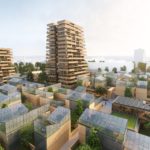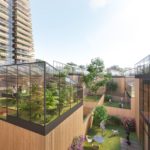Revitalizing Urban Landscape: Quartier am Rotweg Project by Delugan Meissl Associated Architects - Sustainable, Innovative Design for Community Well-being.
Project's Summary
Revitalizing the Urban Landscape: The Quartier am Rotweg Project by Delugan Meissl Associated Architects
Diversity as Guiding Principle:
The Quartier am Rotweg project, part of IBA 27, aims to combine high architectural quality, experimental building methods, and social and ecological aspects. The design envisions a socially-mixed urban quarter that offers high-quality design to a range of user groups while retaining the existing trees. The esplanade, which stretches from Schozacher Straße to the sports pitch, acts as both the entrance to the quarter and a place for meeting outside the buildings. The esplanade connects a series of places that encourage diversity and exchange, which are essential components for a high quality of life and identification with the quarter.
A Horizontal and Vertical Garden Settlement:
The Quartier am Rotweg project proposes two typologies - small-scale detached houses and large-scale high-rise buildings - to offer a wide range of types of home suitable for people at very different stages of their lives. Private, clearly enclosed gardens are consciously preferred to a large, inactive semi-public intermediate space. These intimate, private spaces ensure peace and relaxation, while the esplanade is a central place for coming together and communicating. The towers, which taper upwards to optimize the natural watering of the planters, can be interpreted as a vertical garden city.
Innovation Meets Sustainability - 62% Green Space:
The Quartier am Rotweg project uses conventional building methods for the towers, while the small-scale detached houses are designed as light timber structures built from prefabricated elements and placed on point foundations. This means that much of the site has a very small footprint, and large areas are drained by seepage. The point-foundation method embodies a very sensitive approach to dealing with the complex roots of the existing trees. Timber is a renewable raw material that is largely pollutant-free and has a low level of thermal conductivity and excellent insulating qualities, making it ideal for energy-efficient building. The Quartier am Rotweg project is designed to have only 62% hard surfaces, with the rest of the site covered in greenery.
Climate Concept:
The Quartier am Rotweg project aims to create a forward-looking, climate-fit quarter that offers high-quality open spaces and has no negative impact upon neighboring residents and the urban climate of Stuttgart. The design addresses issues of comfort, overheating in the city, and ventilation from the very beginning of any design process. The project ensures that the layout of the buildings guarantees an adequate level of permeability, forms barriers to neither of the two cold air flows described above, and encourages the growth of trees with large crowns. In addition to this, the Quartier am Rotweg project envisages numerous green roofs and green facades, which increase the probability that they will contain well-watered, healthy plants and have a positive impact on the microclimate.
The Quartier am Rotweg project, with its innovative and sustainable design, offers a blueprint for urban revitalization that prioritizes diversity, community, and ecological well-being. The project's commitment to green space, energy-efficient building, and climate adaptation provides a model for future urban development that balances the needs of residents and the environment.
Read also about the Blending Old and New: Marvel Architects' State Street Townhouses project


